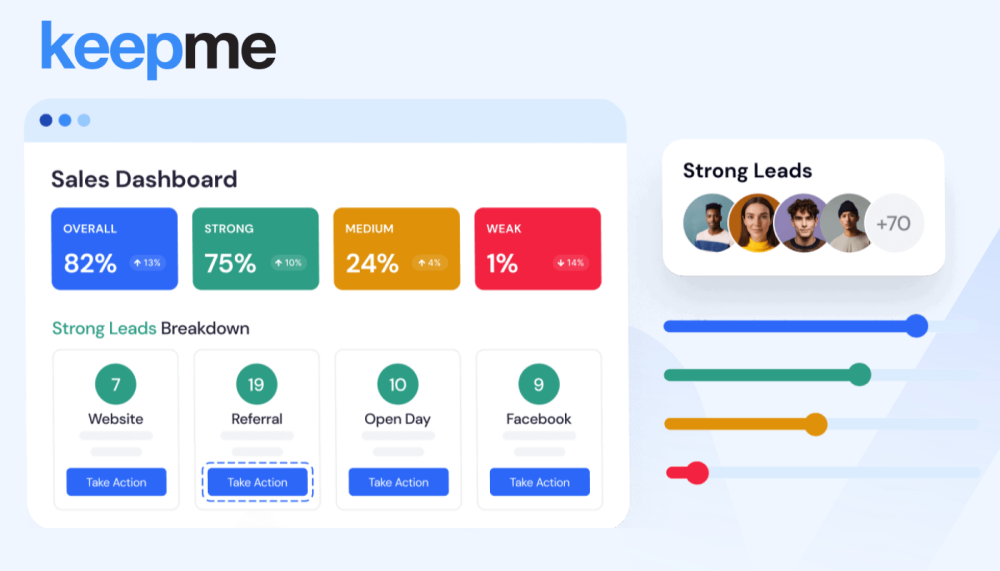Why It’s So Hard to Convert Gym Leads into Paying Members: A Deep Dive


The fitness industry has evolved exponentially over the past decade and realistically gathered its break-neck speed in the last five. We don’t need to get into the environmental, societal, or political reasons for that right now. But, what we will do is look at the personal significance of having a gym membership and how that has seen the gym scene explode (in the best possible way of course). And how, with this burgeoning demand, comes the challenge of converting that overflowing bucket of gym leads into paying members.
Demand drives competition and with competition at an all-time high, converting gym leads is becoming an increasingly complex task. After all, someone somewhere always seems to be shifting the goalposts. Whether it's keeping up with Millennials' expectations, or what the work-from-home brigade will leave the house for, there’s always a new challenge to pivot to or accommodate.
However, with the right mix of traditional strategies, cutting-edge tech innovations, and next-generation data collection, operators can elevate their gym sales and enhance the overall member experience. As the nexus between AI and fitness continues to grow, it's an exciting time for gyms to capitalize on these advancements and redefine their lead conversion landscape.
Let's delve into some of the reasons why converting leads is a complex problem and some strategies that help. We’ll also take a look at the pitfalls of standard member data and what you should develop as part of your fitness brand’s digital transformation.
Problem 1: Inadequate Member Experience
When leads visit a gym or website and are met with an underwhelming or impersonal experience, it can deter them from signing up.
Traditional gym strategies
Personalized Member Journeys
Offering tailored programs based on individual goals and preferences.Feedback Mechanisms
Regularly collecting and acting upon member feedback to continually refine the gym experience.
Advanced gym strategies
Leveraging AI and Machine Learning for Personalization and quality content writing
Learn how to embrace artificial intelligence to craft unique member experiences. AI can analyze member data to suggest an array of personalization approaches. But, understanding how it works and the libraries of data it uses to help you craft those keyword-rich, SEO-optimized gym blogs, and custom workout plans is the first step.
Problem 2: Lack of Clear Engagement
Many gym leads are lost due to a lack of engagement after their initial interest. Understanding what good prospect engagement looks like is absolutely crucial here.
Traditional gym strategies:
Regular Communication
Regularly update leads about new classes, offers, or gym events through newsletters or social media.Interactive Platforms
Offering webinars, virtual tours, or online classes can keep leads engaged.
Advanced gym strategies:
Using AI and Automation for Engagement:
These technologies and fitness data can come together to create tools that engage your gym leads based on their behavior. For example, fitness software can predict when a lead might lose interest and send them a targeted offer.
Problem 3: Outdated Marketing Techniques
Traditional marketing techniques may not resonate with the tech-savvy generation of today.
In fact, one in three millennials is willing to pay more for personalized fitness experiences. And, to get it 60% of them are willing to hand over their personal data and preferences, and they fully expect you to leverage it.
Traditional gym strategies
Diversified Marketing Channels
Knowing how to market a gym is essential. Use social media, influencer partnerships, and online advertising to reach potential customers.Engaging Content
Regularly update blogs, vlogs, or podcasts about health and fitness.
Advanced gym strategies
Intelligent Advertising with AI
Leverage AI to write optimized Google ads, landing pages, and social media posts in your gym’s tone of voice. Then, utilize AI again to target potential leads based on their online behavior, interests, and previous gym interactions.
Problem 4: Insufficient Tools for Fitness Lead Generation
Using outdated tools or not using any tools at all can seriously hamper the lead generation strategy.
Traditional gym strategies
Modern gym CRM systems
Upgrade to a CRM system that can track all lead conversions so you can evaluate campaign progress.Lead Magnets
Offer free resources, like e-books or trial classes, to generate leads.
Advanced gym strategies
Leverage a smart insights platform
Upgrade to an AI-powered membership and prospect engagement system. It can track all lead interactions and member behaviors so you can interject early, reduce member acquisition costs, and iterate faster.AI-Powered Analytics
Understand the nuances of AI and how it can predict potential leads' behavior, interests, and the likelihood of them becoming paying members.
Problem 5: Lack of Understanding About Gym Prospect Needs
Not all fitness leads have the same needs. A one-size-fits-all approach can lead to many lost opportunities.
Traditional gym strategies
Segmentation
Categorize leads based on their interests, fitness goals, and other parameters.Tailored Offers
Provide offers that cater specifically to different segments.
Advanced gym strategies
Predictive Analysis
Use fitness software equipped with AI to predict a lead’s future needs. Based on behavioral pattern recognition in similar members you can apply that to your gym prospects like a blueprint and cater to them in advance.
Problem 6: Inefficient Follow-up System
Your fitness lead might forget about their interest if not followed up in a timely and effective manner. Worse, someone might beat you to it.
Traditional gym strategies
Automated Email Sequences
Set up sequences to nurture leads, reminding them of what they’re missing out on.SMS and Call Follow-ups
The personal touch can make a difference in conversion rates.
Advanced gym strategies
AI-Powered Follow-ups
Using AI to determine the optimal time and method to follow up with leads can drastically improve conversions.
And as promised…
The Pitfalls of Standard Gym Member Data
First things first. If you want to increase your gym lead conversion rate by 60% or more, you’re going to need your data in good shape first.
In today's tech-savvy age, data is the backbone of pretty much every industry, and the fitness sector is no exception. For fitness clubs, member data has traditionally been a goldmine, informing decision-making processes and guiding marketing strategies. However, traditional data collection methods have several inherent limitations.
What Standard Gym Member Data Comprises of
Traditional member data often covers the basics such as:
Personal information
Name, age, gender, address, etc.Membership details
Type of membership, duration, payment records, etc.Attendance
How often a member visits, check-in/check-out times, and maybe which facilities they use.Feedback and survey results
Information is collected sporadically or annually to gauge member satisfaction.
Limitations of Standard Gym Data
Lack of Depth
Such data provides only a superficial understanding of a member's fitness journey. Knowing how often someone comes to the gym doesn't necessarily reveal their goals, challenges, or how engaged they feel.Reactivity, Not Proactivity
Traditional data often paints a picture of the past but offers limited insights into predicting future behaviors or trends.No Personalization
In an era where consumers expect tailored experiences, standard data doesn't provide the depth needed to personalize member interactions truly.Data Silos
Often, member data is stored in isolated systems. For instance, feedback might be in one place, while attendance is in another, making holistic analysis challenging.
The Dawn of Next-Generation Member and Prospect Data
To truly understand members and gym prospects in a way that positively affects your bottom line, you need to delve deeper and embrace next-generation data collection approaches.
Characteristics of Next-Generation Gym Data
Holistic Understanding
Instead of just tracking attendance, next-gen gym data might include which classes a member attended, their heart rate during a session, or even their diet outside the gym.Predictive Analysis
Modern fitness data tools, especially when combined with AI, machine learning, and time decay models, can forecast trends, allowing gyms to anticipate and act on future member needs and act on gym leads faster.Behavioral Insights
This includes understanding the triggers that motivate a member, what demotivates them, their responsiveness to different communication methods, etc.Integration with Other Platforms
Members might be discussing their fitness journey on social media or using health-tracking apps. Integrated data systems can draw insights from these platforms, painting a comprehensive picture of a member's fitness journey.
How This Shift Impacts Market Dynamics:
Gyms and fitness brands that invest in next-generation data tools will have a distinct advantage over their competitors. Here's why:
Enhanced Member Experience
With deeper insights, gyms can offer highly personalized experiences and joining offers, tailor-made nutrition plans, and customized workout recommendations.Proactive Problem Solving
Predictive analysis can help gyms identify potential issues before they become significant problems, be it dwindling member engagement or maintenance needs.Effective Marketing
When gyms understand their members at a granular level, they can craft more compelling and targeted marketing campaigns.Increased Member Loyalty
Personalization and proactivity result in higher member satisfaction, leading to increased retention.
Brands that leverage these advanced data collection and analysis methods will not only enhance their value proposition but are also likely to inherit market share from those still relying on outdated methods. Being data-savvy isn't just an advantage, it's a necessity.
Those who recognize and act on this shift will undoubtedly lead the pack, leaving their competitors to play catch-up.

Want to convert more gym leads?
Book your FREE 15-minute demo and discover how Keepme could increase your lead conversion by 60% and save your team 16-20 hours per team member per month!







